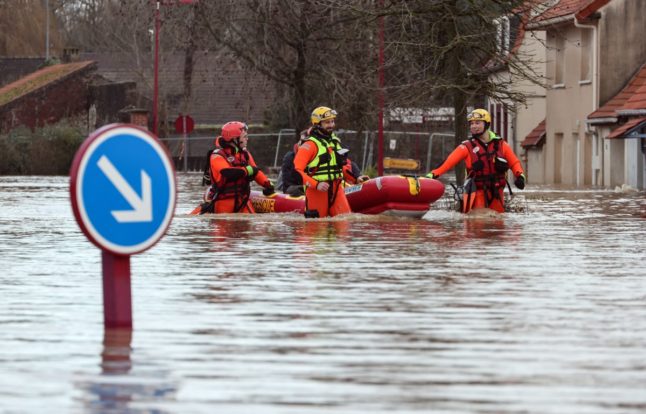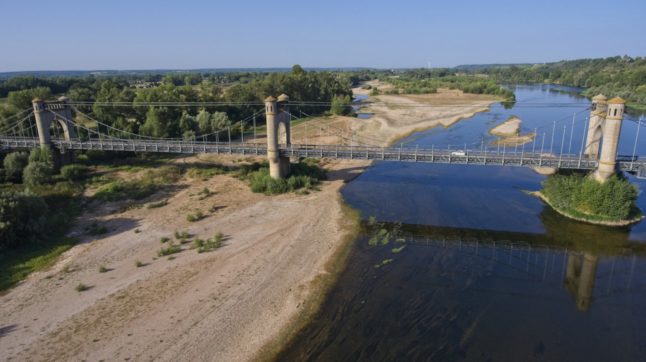Pas-de-Calais, in northern France, remained on the highest alert level for flooding on Thursday, while the body of a man in his seventies was recovered from a partially submerged car in the Loire-Atlantique département.
Flood waters had started to recede along the River Aa, officials said, though the département remained on the highest ‘red’ alert level on Thursday morning.
A further four northern départements – Ardennes, Aisne, Meuse and Nord – were kept under orange weather warnings, the second-highest, in forecaster Météo-France’s early bulletin.
🔴 1 département en Rouge
🔶 4 départements en Orange (https://t.co/CSYEovTI83) pic.twitter.com/2EMsEXcPiZ— VigiMétéoFrance (@VigiMeteoFrance) January 4, 2024
All five departments were set to remain on the same heightened alert levels into Friday at least, Météo-France indicated.
In Pas-de-Calais, 1,299 homes in 189 communes were affected by flooding along the rivers Aa, Liane, Hem, Canche, Lys-Plaine, Lys-Plaine, Lys-Amont and Lawe-Clarence, according to the Pas-de-Calais prefecture on Wednesday evening, as flood waters reached their peak along the Aa.
READ ALSO How to ensure your French property is insured for storm damage
A total of 450 firefighters from the Pas-de-Calais department were mobilised overnight, along with 120 additional firefighters and members of regional civil security training units from other areas. Rescuers carried out 115 evacuations in the area on Wednesday, bringing the total to 371 since Sunday.
Elsewhere, a 73-year-old man was found dead in his partially submerged car near Nantes, after apparently driving on a road closed to traffic due to flooding in the area. The victim’s partner had raised the alarm 24 hours earlier, after he had gone out for bread in the town of Saffré.
This is the third time parts of Pas-de-Calais have flooded since November. Between October 17th and December 31st, 464mm of precipitation was recorded in Pas-de-Calais. Over the same period in 2022, 296mm of rain fell.
There is no immediate let-up in the weather for those affected by the floods. Further rain and strong winds are forecast for northern and northwestern France on Thursday.
But a change from the mild, rainy conditions over Christmas and New Year is forecast from the weekend, as a colder, mostly drier air pushes into the country.
🥶 Un changement radical de masse d'air se confirme à partir du week-end des 6 & 7 janvier 2024 avec l'installation d'un flux continental sensiblement plus #froid. Plus d'infos dans notre article ➡️ https://t.co/Xp5gqA1V4Z pic.twitter.com/SI0Gdw60q8
— Guillaume Séchet (@Meteovilles) January 3, 2024
A dip in temperatures is expected from Friday morning. By Sunday, the mercury is set to rise no higher than between 0C and 2C at dawn across most of the country.
Morning frosts will become widespread from Sunday, January 7th, with temperatures dropping as low as -5C in the Massif Central and to the east of the country for much of the week.
As children return to school after the Christmas holidays, morning temperatures in Paris, Amiens, Strasbourg and Aurillac are expected to remain noticeably below zero, while a chill wind is set to make it feel even colder.
Snow is expected in mountain regions at the weekend and, at higher altitudes, temperatures could fall as low as -10C, forecasters warned.
❄️ La #neige fera son retour ce week-end, à des altitudes de plus en plus basses dans l'est et sur le centre du pays. Et bonne nouvelle, tous les massifs montagneux en bénéficieront ! pic.twitter.com/FXM1On8HhS
— La Chaîne Météo (@lachainemeteo) January 3, 2024



 Please whitelist us to continue reading.
Please whitelist us to continue reading.
Member comments